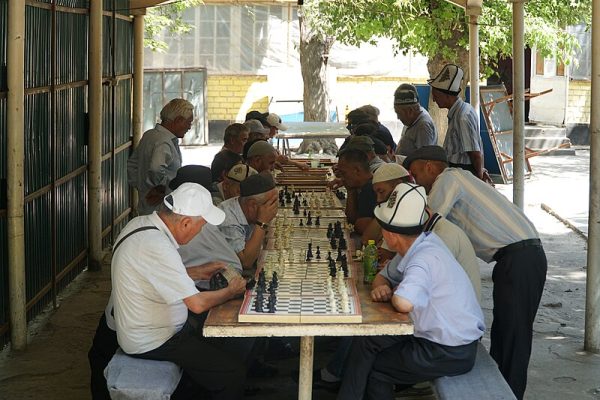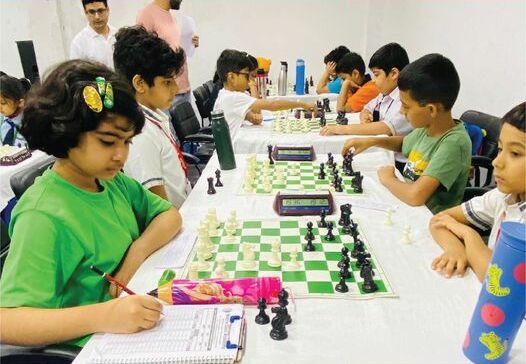Imagine two people sit on opposite sides of a table — the only thing separating them is a small, checkered black and white board. Each of them intently stares at the board, contemplating what their next move is– to go for an attack? Or no, to defend? The weight of the game rests upon this moment, and each player understands that it is going to be a close match.
I bet you imagined two men sitting across from each other, with their backs hunched over the board. So, why do you immediately only imagine men? Well, if you’re unfamiliar with the game of chess and have only seen a few of the big, flashy names — Magnus Carlson or Garry Kasparov — you may have realized that nearly none of the “popular” players are women.
There is an overwhelming majority of male players, especially competitively – it’s a fact. Aliya Saldanha Suri ’27, a competitive chess player and member of the chess club, said, “I don’t remember the last time I played a girl who wasn’t at an all-girls tournament.”
Suri began playing chess in kindergarten and started competing in first grade. When she was a young child, she moved to India. However, when she went to India, she describes how she “stopped playing chess, because there were barely any girls.” It was discouraging when she lacked female opponents to play with, as in a way, she was alone in the chess world. This occurs worldwide — the gender inequality is omnipresent.

In the past, many have established this gender bias simply based on observations without raw data backing up their claims. This recently changes, as a study published by NYU (with contributions by Jennifer Shahade, two-time U.S. Women’s Champion) proved the gender bias in chess to be statistically true.
Researchers (Arnold S., Bailey A., Ji Ma W., and Cimpian A.) searched for a proven answer about gender bias, and they found answers by interviewing parents and mentors and examining their possible bias against female youth. Parents were told to rate their children (and coaches to rate their students) in terms of their potential abilities in chess development by measuring factors such as a willingness to spend money into consideration. Generally, willingness to spend money is associated with belief that investment will reap success – in this situation, that their children would become good at chess.
Parents and mentors were asked to give evaluations on almost 650 youth chess players, in terms of “if they thought aptitude in chess requires brilliance.” The researchers found the results to confirm their original suspicions: bias against girls in chess is unarguably present. Parents and mentors generally evaluated male youth players more positively than female youth players, believing that males will have a higher future rating.
The mentors and parents who believed that “brilliance” is required to aptly play chess also supported the notion that female players generally lack this quality and are more likely to quit the game due to poor skill. This group also did not believe that girls face a less supportive environment than boys in chess, disagreeing that this issue causes girls to quit the game. They also did not recognize that their assumptions can create extra challenges for girls to play and succeed in chess.
As can be seen from the study, gender bias truly does exist. Female players who are entering the playing field of the male-dominated game immediately face a disadvantage. On the other hand, male players do not face the same obstacles. The fact that this disadvantage is due to adults and their poor leadership is a concept that many have not considered. It is imperative to understand this perspective in order to address the gender bias in chess.
Now that we have discussed guardian’s and coaches point of view, what about the actual players themselves? In a study, 77 girls were surveyed between the ages of 6 and 11, all of which played chess: they each displayed awareness of the stereotype that boys are better at playing chess than girls.
Female elementary school students who are interested in pursuing a game doubt their abilities due to a false stereotype. This is especially harmful as they are presented with this idea at a young age – these girls will essentially grow up with this mindset, doubting themselves compared to boys. As a result, these girls have a significantly higher chance of avoiding the game in the future.
Later in the same study, the same researchers tested to see if girls quit chess after such discouragement. They discovered that after girls performed worse than they expected, they went on to play fewer tournaments the next year. Their male counterparts did not experience the same trend.
Guardian discouragement, paired with the fact that girls expect failure, likely contributes to the lack in girl’s resilience in response to poor performance. As a result, far fewer women continue playing chess into their teenage and adult years, and hence often do not pursue a Grandmaster/Master title (these are titles given when certain winning conditions and/or rating levels are met: more information can be found here.)
Now, what about the few women that do continue playing chess in the professional setting? In general, there are significantly fewer female chess players than their male counterparts, even at the highest levels. Out of over 1,600 international chess grandmasters, only 37 are women — a little over 2%.
Women are also treated in an unequal manner compared to men. In general, women’s chess tournament prizes are significantly smaller than those in men’s tournaments. In the Women’s World Chess Championship – the most elite women’s chess tournament – the female champion, Ju Wenjun, took home a prize that was 10% smaller than the prize the male champion walked away with from the World Chess Championship.
In addition, many male professional competitors have skewed views of their female opponents. Former world champion Garry Kasparov once differentiated between “real chess” and “women’s chess,” insinuating that women cannot play “real” chess.
One of the most successful and highest rated female players of all time, Judit Polgar, expresses that her male opponents have often blamed their losses against her due to “headaches.” They often did so to excuse their loss, as if they believe a woman cannot simply be more skilled than them at chess. The difficulties of gender bias are truly prevalent in all levels of chess – from beginner, to intermediate, to professional players.
Suri, an intermediate level chess player, agrees with this notion. She says that her male opponents have often tried to intimidate her in various ways before her matches against them. For example, she recounts that male opponents would purposefully bring their other male friends over to their board and talk loudly with them before the start of the match, as a means of appearing overly-confident. They often did so in order to get an “upper hand” as they subconsciously thought girls are less skilled.
Now that we acknowledge the problem, we must look beyond these studies and take the first step in alleviating it by recognizing and addressing this gender bias. Spreading awareness of the unfair circumstances can influence the prejudiced to rethink their beliefs regarding female youth and their potential in chess. By educating adults on how harmful their assumptions are, the gender bias can dissipate and stop limiting females in chess.
Encouraging female youth to participate and play chess in schools, tournaments, and organizations is also a huge step in the right direction, as it helps these players find a nurturing community. This can in turn prevent the growing issue of girls quitting chess due to a lack of support.
If you are a girl interested in chess, or know girls who are intrigued by chess, I recommend the Her Move Next organization. Her Move Next is a non-profit organization that aims to empower girls worldwide by mentoring them in chess. Its intentions are to fight the gender inequality in chess that is so prevalent in our current world, as it builds a strong, supportive community.
Suri is a coach at Her Move Next, and she stresses just how important organizations that support these communities of girls are. “At Her Move Next, we host monthly tournaments, and we do lessons and events. It’s all girls’ chess, and it’s encouraging – it builds a community within chess while encouraging healthy competition.”
She says she has observed notable impacts from the girls – who range from being in elementary school to middle school – whom she coaches in Her Move Next. “I know a lot of girls who think chess is interesting, keep playing it, and don’t stop playing because they have a community, and because they get to build friendships with other girls especially in Her Move Next.”
What’s most important is for female players to uplift and support other female players, even at competitions when they may play against one another. If a strong community of girls in chess can be formed, then any hurdle can be overcome. Working together, this can truly be achieved in the future, promising better opportunities to all women in chess.
What’s most important is for female players to uplift and support other female players, even at competitions when they may play against one another. If a strong community of girls in chess can be formed, then any hurdle can be overcome. Working together, this can truly be achieved in the future, promising better opportunities to all women in chess.

